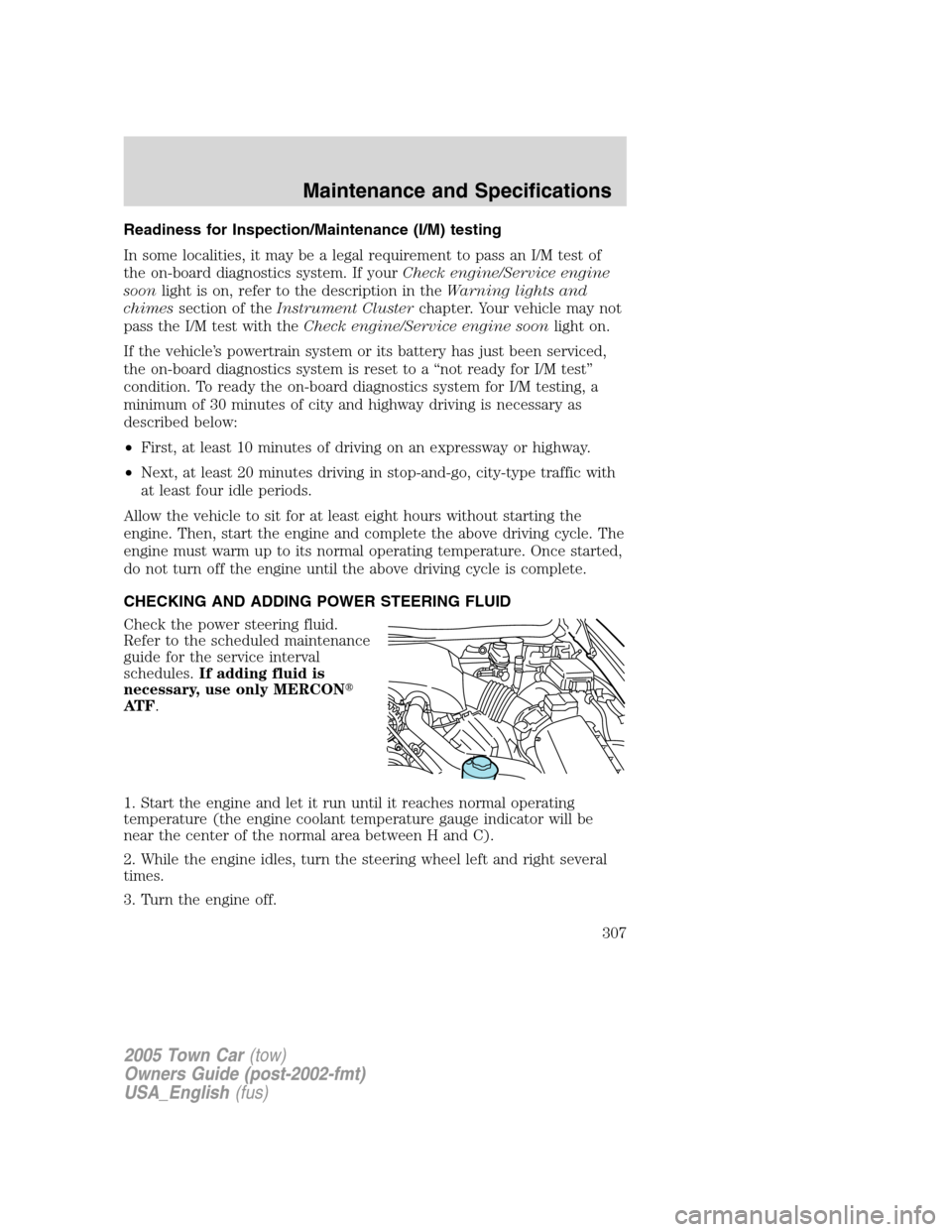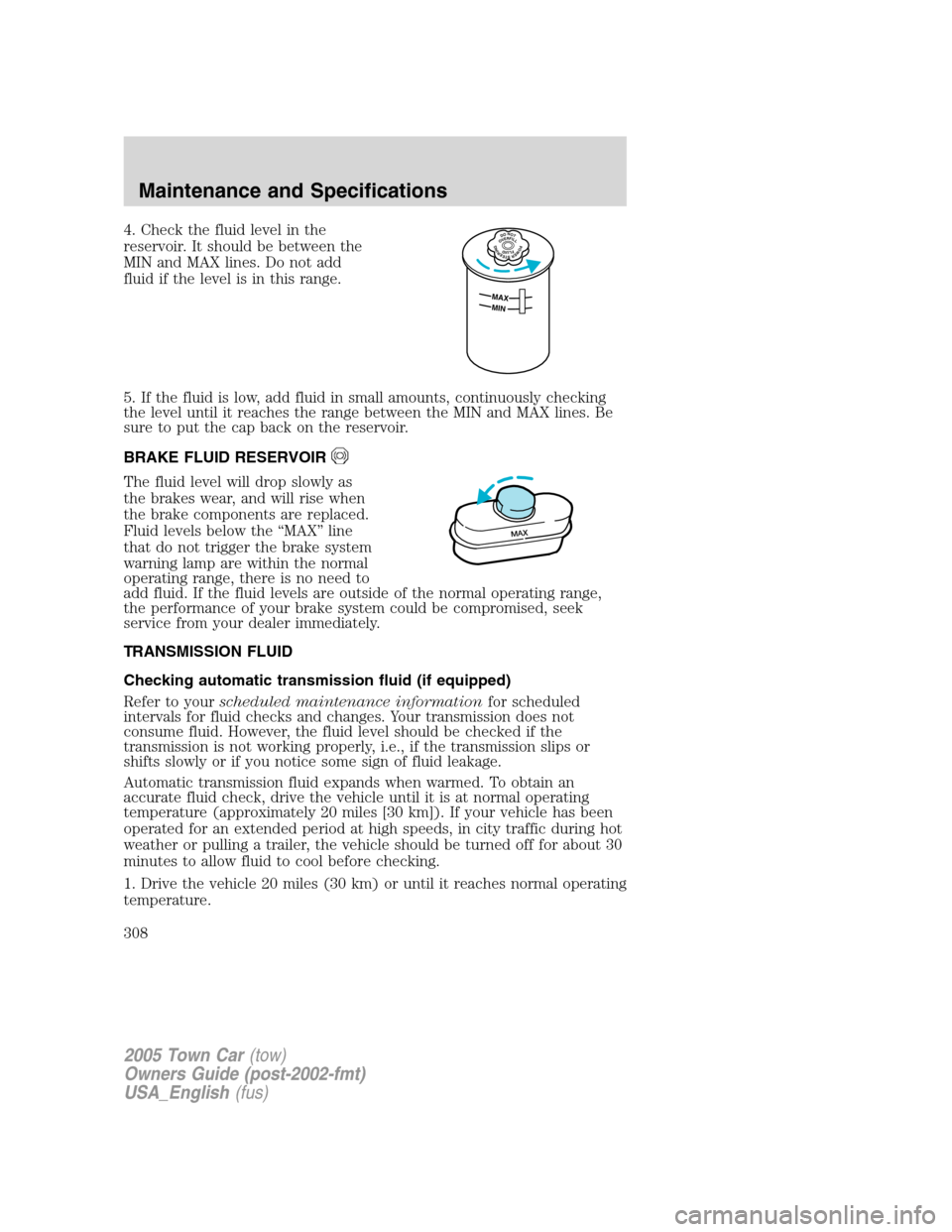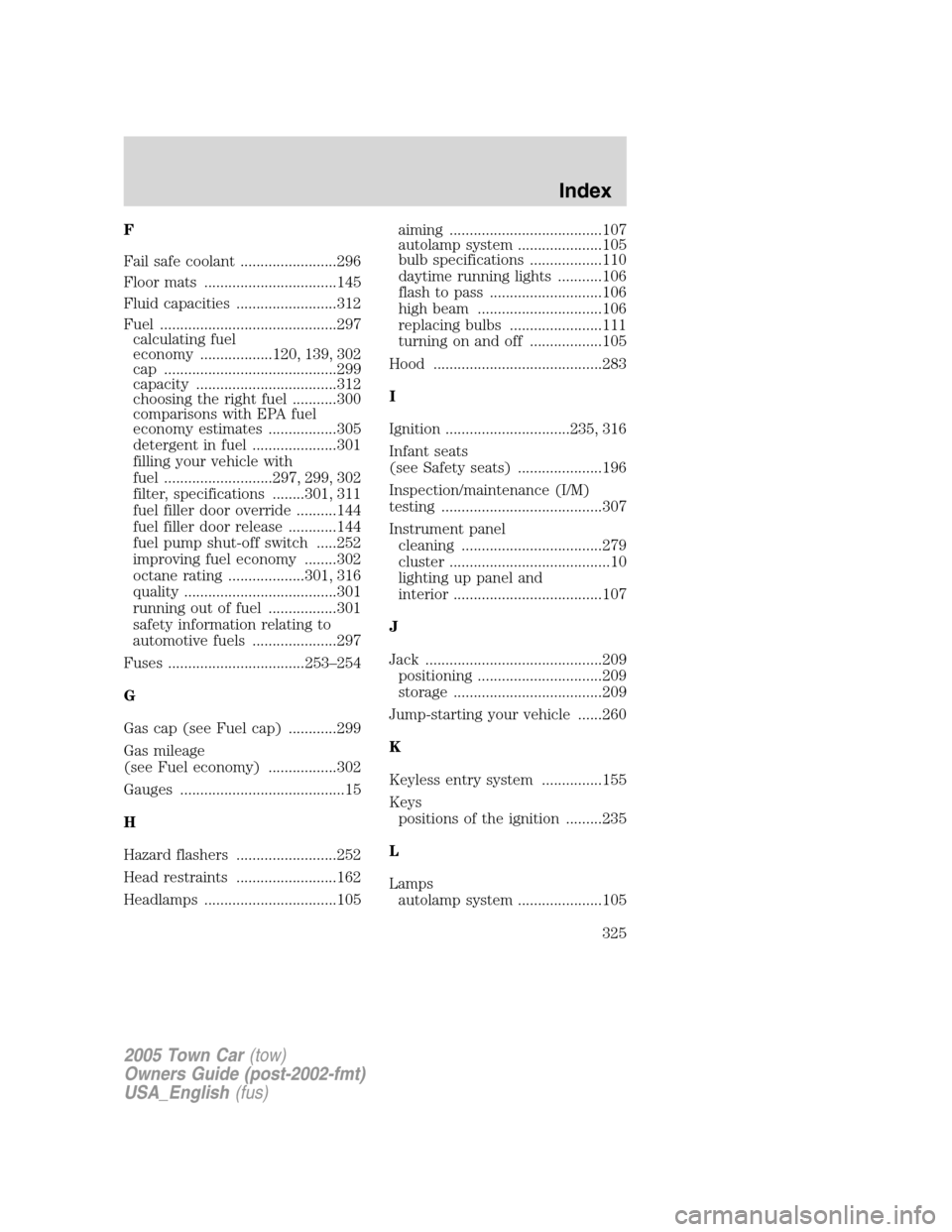Page 307 of 328

Readiness for Inspection/Maintenance (I/M) testing
In some localities, it may be a legal requirement to pass an I/M test of
the on-board diagnostics system. If yourCheck engine/Service engine
soonlight is on, refer to the description in theWarning lights and
chimessection of theInstrument Clusterchapter. Your vehicle may not
pass the I/M test with theCheck engine/Service engine soonlight on.
If the vehicle’s powertrain system or its battery has just been serviced,
the on-board diagnostics system is reset to a “not ready for I/M test”
condition. To ready the on-board diagnostics system for I/M testing, a
minimum of 30 minutes of city and highway driving is necessary as
described below:
•First, at least 10 minutes of driving on an expressway or highway.
•Next, at least 20 minutes driving in stop-and-go, city-type traffic with
at least four idle periods.
Allow the vehicle to sit for at least eight hours without starting the
engine. Then, start the engine and complete the above driving cycle. The
engine must warm up to its normal operating temperature. Once started,
do not turn off the engine until the above driving cycle is complete.
CHECKING AND ADDING POWER STEERING FLUID
Check the power steering fluid.
Refer to the scheduled maintenance
guide for the service interval
schedules.If adding fluid is
necessary, use only MERCON�
AT F.
1. Start the engine and let it run until it reaches normal operating
temperature (the engine coolant temperature gauge indicator will be
near the center of the normal area between H and C).
2. While the engine idles, turn the steering wheel left and right several
times.
3. Turn the engine off.
2005 Town Car(tow)
Owners Guide (post-2002-fmt)
USA_English(fus)
Maintenance and Specifications
307
Page 308 of 328

4. Check the fluid level in the
reservoir. It should be between the
MIN and MAX lines. Do not add
fluid if the level is in this range.
5. If the fluid is low, add fluid in small amounts, continuously checking
the level until it reaches the range between the MIN and MAX lines. Be
sure to put the cap back on the reservoir.
BRAKE FLUID RESERVOIR
The fluid level will drop slowly as
the brakes wear, and will rise when
the brake components are replaced.
Fluid levels below the “MAX” line
that do not trigger the brake system
warning lamp are within the normal
operating range, there is no need to
add fluid. If the fluid levels are outside of the normal operating range,
the performance of your brake system could be compromised, seek
service from your dealer immediately.
TRANSMISSION FLUID
Checking automatic transmission fluid (if equipped)
Refer to yourscheduled maintenance informationfor scheduled
intervals for fluid checks and changes. Your transmission does not
consume fluid. However, the fluid level should be checked if the
transmission is not working properly, i.e., if the transmission slips or
shifts slowly or if you notice some sign of fluid leakage.
Automatic transmission fluid expands when warmed. To obtain an
accurate fluid check, drive the vehicle until it is at normal operating
temperature (approximately 20 miles [30 km]). If your vehicle has been
operated for an extended period at high speeds, in city traffic during hot
weather or pulling a trailer, the vehicle should be turned off for about 30
minutes to allow fluid to cool before checking.
1. Drive the vehicle 20 miles (30 km) or until it reaches normal operating
temperature.
DONOTOVERFILLPOWERSTEERINGFLUID
MAX
MIN
MAX
2005 Town Car(tow)
Owners Guide (post-2002-fmt)
USA_English(fus)
Maintenance and Specifications
308
Page 325 of 328

F
Fail safe coolant ........................296
Floor mats .................................145
Fluid capacities .........................312
Fuel ............................................297
calculating fuel
economy ..................120, 139, 302
cap ...........................................299
capacity ...................................312
choosing the right fuel ...........300
comparisons with EPA fuel
economy estimates .................305
detergent in fuel .....................301
filling your vehicle with
fuel ...........................297, 299, 302
filter, specifications ........301, 311
fuel filler door override ..........144
fuel filler door release ............144
fuel pump shut-off switch .....252
improving fuel economy ........302
octane rating ...................301, 316
quality ......................................301
running out of fuel .................301
safety information relating to
automotive fuels .....................297
Fuses ..................................253–254
G
Gas cap (see Fuel cap) ............299
Gas mileage
(see Fuel economy) .................302
Gauges .........................................15
H
Hazard flashers .........................252
Head restraints .........................162
Headlamps .................................105aiming ......................................107
autolamp system .....................105
bulb specifications ..................110
daytime running lights ...........106
flash to pass ............................106
high beam ...............................106
replacing bulbs .......................111
turning on and off ..................105
Hood ..........................................283
I
Ignition ...............................235, 316
Infant seats
(see Safety seats) .....................196
Inspection/maintenance (I/M)
testing ........................................307
Instrument panel
cleaning ...................................279
cluster ........................................10
lighting up panel and
interior .....................................107
J
Jack ............................................209
positioning ...............................209
storage .....................................209
Jump-starting your vehicle ......260
K
Keyless entry system ...............155
Keys
positions of the ignition .........235
L
Lamps
autolamp system .....................105
2005 Town Car(tow)
Owners Guide (post-2002-fmt)
USA_English(fus)
Index
325